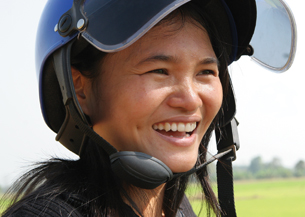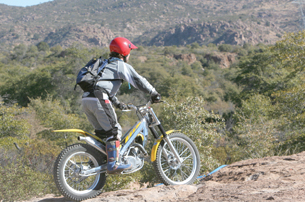Module 1
1. Module 1
1.7. Page 2
Module 1—Momentum and Impulse
 Explore
Explore

© Joe Gough/shutterstock
People who ride motorcycles do not have the protection of airbags if they are involved in a crash. So other safety features are used to reduce injuries in this case.
Helmets are an essential component of the safety systems that protect people who ride motorcycles. The role of the cushioning in the lining of the helmet is explored in the next activity.
 Try This
Try This
Complete “9-2 QuickLab: Softening the Hit” on page 455 of your textbook. If you do not have access to putty-type material, you can try one of these recipes for playdough.
 Self-Check
Self-Check
SC 1. Answer questions 1, 2, and 3 of the QuickLab on page 455 of your textbook.
Hint: In your answer to question 3, start with this equation,![]() .
.
 Self-Check Answer
Self-Check Answer
SC 1.
- The putty ball that landed on the hardest surface was the most deformed. The putty ball that landed on the surface that was the most cushioned was the least deformed. The putty ball that landed on the third surface—having intermediate cushioning—experienced an intermediate amount of deformation.
- The putty ball that landed on the hardest surface was the most deformed. The putty ball that landed on the most-cushioned surface was the least deformed.
- The instant prior to striking the surface, the putty ball had an initial velocity. Once contact was made with the surface, the putty ball began to decelerate and it eventually came to a stop, making vf = 0. The time to bring the ball to a stop is Δt, and the distance required to stop the ball is Δd. The cushioning material is compressed this distance (Δd) while stopping.
Look at the following analysis of the equation. It shows that the greater the compression of the material, the greater the stopping distance. This shows that the time interval required to bring the ball to a stop is greater.


© Casey K. Bishop/shutterstock
The QuickLab demonstrated that if cushioning is present as an object loses its momentum and comes to a stop, then the forces required to stop the object can be reduced. In the case of the putty ball, the evidence of the magnitude of the stopping force is the amount of deformation of the ball.
Since a motorcyclist rarely travels over cushioned surfaces, the motorcyclist must carry his or her own cushioning—it's in the lining of the helmet. This cushioning helps to reduce the negative impact of forces acting on the rider’s head during a crash.
 Read
Read
To learn more about the connections between the type of surface and the severity of injuries, read pages 454 to 456 in your textbook. Pay close attention to the relationship between stopping time and force on page 456.
 Self-Check
Self-Check
SC 2. Explain why maximizing the stopping time has the effect of minimizing the stopping force.
 Self-Check Answer
Self-Check Answer
SC 2.
In the previous lesson you learned that Newton's second law can be expressed in terms of the change in momentum.
![]()
If this equation is rearranged, it can be shown that the change in momentum is equal to the net force multiplied by the time interval.

If identical eggs are dropped from the same height onto a surface, the change in momentum will be identical for both eggs. However, if the stopping time interval for one egg is maximized, then the force that egg experiences can be minimized.